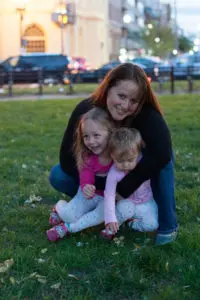Tearing Down A House
Are you thinking of building your dream home but don’t know if you should start on a vacant lot? What do you need to know? What is involved with financing a teardown and rebuild? In this video, I’m going to explain the pros and cons of starting on vacant land versus tearing down a house to rebuild a custom home. We’ll chat with my husband and land developer Jim to understand all the details of building fresh on your own lot.
Build on Vacant Land Or Tear Down?
Looking for a piece of land where you can build your dream house can be a nightmare for some. You might think it’s a better option to buy a property with a small house, tear it down, and build your own. You’ve probably heard people talk about this process as McMansioning. This is where a small rambler house on a lot is knocked down and replaced with a giant house—usually, that almost goes to the edge of the lot line.
Others think that a piece of vacant land is better, feeling that they can start fresh and build from scratch. While this might sound like a great idea, there are many reasons why that may not be the best thing for you. Vacant land needs infrastructure, like water, sewer, and utilities. There are all kinds of things that you need to do before you can even go in and pour a foundation.
When developers buy huge parcels of land to subdivide, they can often afford to bring utilities in because they’re spreading these costs over many, many lots. However, if you’ve got one little lot and any small thing goes wrong, it may cost you a small fortune to fix it. If that sounds like a pain in the asphalt, we have another option for you.
Understanding The Process Of Tearing Down
One option is to find a house that’s in a state of disrepair and tear it down. I know that sounds crazy, but sometimes this is the better way to go. Unless you tear a Unabomber-type house where the tenant was living out in the middle of the woods with no utilities or running water, you can assume there are already utilities available. If you buy a lot with a house that’s already there, most of the hard work has been done for you.
The Feasibility Study
While it’s usually easy to reconnect to these utilities, it does depend on the property. The size of the house you’re going to build is a consideration. For example, if you have a three-inch sewer but the new house is going to have six bathrooms, you may have to upgrade to a larger sewer. You may also have to upgrade your water. In some cases, you have to move the sewer altogether. These are incidental expenses on the cost of a house, though, so it’s not a big deal.
If the house has a septic system, the septic system may no longer be approved for that area. You may have to look at your options to upgrade the septic system or connect to the public sewer if available. Again, these are things that go along with the construction of a house, and you can figure these items out pretty quick. Once you get through all of that, that’s essentially your feasibility study. When it’s an existing house, a lot of times sellers don’t care what your end goal is with it. They’re not necessarily going to give you a 90-day feasibility study.
Do The Work Ahead Of Time
If you have a short time—say, 10 days—to do a study to see if you can rebuild your dream house on a lot, the best bet is to start ahead of time. You’ll want to have a basic idea of what kind of house you want to build, what size building pad you need on your lot, and whether it will fit there.
This will avoid zoning issues and only requires a call or visit to the jurisdiction (town, county) office in charge. If your house is going to be much larger than what’s on the lot or you’re going to have a variance issue, you’ll need to make sure your plan will work. Overall, you can save a lot of time tearing down a house instead of building on vacant land.
Demo Permits & Impact Fees
Once you’ve got all that done and it’s satisfactory to your plans, you will close on the property. Then it’s time to get the demo permit. Once you do, you can start to build. Permits are required both to tear down and to build. This is because they want to make sure you’re disconnected from all utilities and that you have a way of getting the trucks in and out of the property without disturbing your neighbors. It’s not a difficult process. The cost to demo a house is approximately $20,000.
Additionally, most jurisdictions have an impact fee for adding another household. When you’re building a new house, this fee is because you’re going to be adding more kids to the schools and more cars to the roads. The impact fee is to offset the extra services that are going to have to go to that piece of land. Teardowns, though, typically do not include impact fees.
However, counties are changing their legislation so that they can start getting impact fees when there is a teardown. This is because they’ve determined that all the new housing isn’t necessarily what brings new traffic and new kids to the schools. Rather, it’s all the resales with bigger families that are bringing traffic and kids to the schools. They now want to go back and charge impact fees on these houses that were built and never had to pay it to begin with. These fees can be significant depending on the age of the house, even up to $30,000 – $40,000.
The Pros And Cons Of Tearing Down
Overall, tearing down is easier than developing a raw piece of land, mainly because you’ve got a lot of the infrastructure there already. The pros include utilities already on-site and saving an unbelievable amount of time not having to jump through county, city, and jurisdiction hurdles.
There are some cons to the process as well. Some sellers try to make a couple of quick repairs just to get more money or to have it sell quicker, not realizing the person buying is going to tear it down anyway. The buyer does not really care that a seller upgraded the countertops or put in new windows because it’s all coming down. Another con is the market, as more and more people want to do these tear-downs. If you go to a desirable place like McLean or Bethesda, you have builders who don’t want to go through the whole land development process because it’s not their forte. They’ve been buying these tear-downs, and the pricing has gotten quite high on them. There’s currently a lot of competition.
Another con is that the average person that’s not well versed in the process—who are simply trying to buy a house to tear down—may not have the financing, education and the knowledge to be able to quickly strike on something where a builder might.
Should You Tear Down Or Build?
As a buyer, doing a tear-down and building the house doesn’t have much to do with profit. Rather, they simply want to build their dream home and live in it. They’re not building their house to have equity from the first day. Builders typically offer less on these homes because they are trying to get between 14% and 20% profit.
I hope this helped you decide between building on vacant land and buying a teardown. These pros and cons can help you choose whether or not developing a vacant piece of land makes sense for you or if you’d rather buy a house to tear down and build your dream home. If you have any questions about the process, please feel free to reach out to me. I would be happy to guide you along the way.





